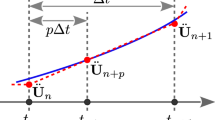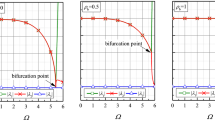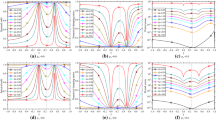Abstract
This paper focuses mainly on the development of composite sub-step explicit algorithms for solving nonlinear dynamic problems. The proposed explicit algorithms are required to achieve the truly self-starting property, so avoiding computing the initial acceleration vector, and the controllable numerical dissipation at the bifurcation point, so eliminating spurious high-frequency components. With these two requirements, the single and two sub-step explicit algorithms with truly self-starting property and dissipation control are developed and analyzed. The present single sub-step algorithm shares the same spectral accuracy as the known Tchamwa–Wielgosz scheme, but the former possesses some advantages for solving wave propagation problems. The present two sub-step algorithm provides a larger stability limit, twice than those of single step schemes, due to explicit solutions of linear systems twice within each time increment. Numerical examples are also simulated to show numerical performance and superiority of two novel explicit methods over other explicit schemes.






























Similar content being viewed by others
References
Hughes, T.J.R.: The Finite Element Method: Linear Static and Dynamic Finite Element Analysis. Dover Publications, Dover Civil and Mechanical Engineering, Mineola (2000)
Bathe, K.J.: Finite Element Procedures, 2nd edn. Prentice Hall, Englewood Cliffs (1996)
Chopra, A.K.: Dynamics of Structures: Theory and Applications to Earthquake Engineering. Prentice-Hall International Series in Civil Engineering and Engineering Mechanics, 4th edn. Prentice Hall, Upper Saddle River (2011)
Newmark, N.M.: A method of computation for structural dynamics. J. Eng. Mech. Div. 85(3), 67–94 (1959)
Shao, H., Cai, C.: A three parameters algorithm for numerical integration of structural dynamic equations. Chin. J. Appl. Mech. 5(4), 76–81 (1988)
Chung, J., Hulbert, G.M.: A time integration algorithm for structural dynamics with improved numerical dissipation: the generalized-\(\alpha \) method. J. Appl. Mech. 60(2), 371–375 (1993)
Wood, W., Bossak, M., Zienkiewicz, O.: An alpha modification of Newmark’s method. Int. J. Numer. Methods Eng. 15(10), 1562–1566 (1980)
Hilber, H.M., Hughes, T.J.R., Taylor, R.L.: Improved numerical dissipation for time integration algorithms in structural dynamics. Earthq. Eng. Struct. Dyn. 5(3), 283–292 (1977)
Wilson, E.L., Farhoomand, I., Bathe, K.J.: Nonlinear dynamic analysis of complex structures. Earthq. Eng. Struct. Dyn. 1(3), 241–252 (1972)
Hulbert, G.M., Chung, J.: Explicit time integration algorithms for structural dynamics with optimal numerical dissipation. Comput. Methods Appl. Mech. Eng. 137(2), 175–188 (1996)
Chung, J., Lee, J.M.: A new family of explicit time integration methods for linear and non-linear structural dynamics. Int. J. Numer. Methods Eng. 37(23), 3961–3976 (1994)
Tamma, K.K., Namburu, R.R.: A robust self-starting explicit computational methodology for structural dynamic applications: architecture and Representations. Int. J. Numer. Methods Eng. 29(7), 1441–1454 (1990)
Li, J., Li, X., Yu, K.: Enhanced studies on the composite sub-step algorithm for structural dynamics: the Bathe-like algorithm. Appl. Math. Model. 80, 33–64 (2020)
Noh, G., Bathe, K.J.: The Bathe time integration method with controllable spectral radius: the \(\rho _\infty \)-Bathe method. Comput. Struct. 212, 299–310 (2019)
Li, J., Yu, K.: An alternative to the Bathe algorithm. Appl. Math. Model. 69, 255–272 (2019)
Li, J., Yu, K., He, H.: A second-order accurate three sub-step composite algorithm for structural dynamics. Appl. Math. Model. 77, 1391–1412 (2020)
Wen, W., Deng, S., Wang, N., Duan, S., Fang, D.: An improved sub-step time-marching procedure for linear and nonlinear dynamics with high-order accuracy and high-efficient energy conservation. Appl. Math. Model. 90, 78–100 (2021)
Kim, W.: An improved implicit method with dissipation control capability: the simple generalized composite time integration algorithm. Appl. Math. Model. 81, 910–930 (2020)
Li, J., Yu, K.: A truly self-starting implicit family of integration algorithms with dissipation control for nonlinear dynamics. Nonlinear Dyn. 102, 2503–2530 (2020)
Hilber, H.M., Hughes, T.J.R.: Collocation, dissipation and ‘overshoot’ for time integration schemes in structural dynamics. Earthq. Eng. Struct. Dyn. 6(1), 99–117 (1978)
Li, J., Yu, K., Li, X.: An identical second-order single step explicit integration algorithm with dissipation control for structural dynamics. Int. J. Numer. Methods Eng. (2020). https://doi.org/10.1002/nme.6574
Cook, R.D., Malkus, D.S., Plesha, M.E., Witt, R.J.: Concepts and Applications of Finite Element Analysis, 4th edn. Wiley, Hoboken (2001)
Borst, R.D., Crisfield, M., Remmers, J., Verhoosel, C.: Nonlinear Finite Element Analysis of Solids and Structures. Wiley Series in Computational Mechanics, 2nd edn. Wiley, Hoboken (2012)
Hughes, T.J.R., Liu, W.K.: Implicit–explicit finite elements in transient analysis: stability theory. J. Appl. Mech. 45(2), 371–374 (1978)
Miranda, I., Ferencz, R.M., Hughes, T.J.R.: An improved implicit–explicit time integration method for structural dynamics. Earthq. Eng. Struct. Dyn. 18(5), 643–653 (1989)
Noh, G., Bathe, K.J.: An explicit time integration scheme for the analysis of wave propagations. Comput. Struct. 129, 178–193 (2013)
Kim, W., Reddy, J.N.: Novel explicit time integration schemes for efficient transient analyses of structural problems. Int. J. Mech. Sci. 172, 105429 (2020)
Kim, W.: A new family of two-stage explicit time integration methods with dissipation control capability for structural dynamics. Eng. Struct. 195, 358–372 (2019)
Rezaiee-Pajand, M., Karimi-Rad, M.: An accurate predictor–corrector time integration method for structural dynamics. Int. J. Steel Struct. 17(3), 1033–1047 (2017)
Namburu, R.R., Tamma, K.K.: A generalized \(\gamma _s\)-family of self-starting algorithms for computational structural dynamics. AIAA J. (1992). https://doi.org/10.2514/6.1992-2330
Soares, D., Jr.: An enhanced explicit time-marching technique for wave propagation analysis considering adaptive time integrators. Comput. Methods Appl. Mech. Eng. 363, 112882 (2020)
Soares, D., Jr.: An explicit family of time marching procedures with adaptive dissipation control. Int. J. Numer. Methods Eng. 100(3), 165–182 (2014a)
Zhang, H.M., Xing, Y.F.: Two novel explicit time integration methods based on displacement–velocity relations for structural dynamics. Comput. Struct. 221, 127–141 (2019)
Rio, G., Soive, A., Grolleau, V.: Comparative study of numerical explicit time integration algorithms. Adv. Eng. Softw. 36(4), 252–265 (2005)
Maheo, L., Rio, G., Grolleau, V.: On the use of some numerical damping methods of spurious oscillations in the case of elastic wave propagation. Mech. Res. Commun. 38(2), 81–88 (2011)
Maheo, L., Grolleau, V., Rio, G.: Numerical damping of spurious oscillations: a comparison between the Bulk-Viscosity method and the Tchamwa–Wielgosz dissipative explicit scheme. Comput. Mech. 51(1), 109–128 (2013)
Li, J., Yu, K., Li, X.: A novel family of controllably dissipative composite integration algorithms for structural dynamic analysis. Nonlinear Dyn. 96(4), 2475–2507 (2019)
Yu, K.: A new family of generalized-\(\alpha \) time integration algorithms without overshoot for structural dynamics. Earthq. Eng. Struct. Dyn. 37(12), 1389–1409 (2008)
Li, J., Yu, K.: A novel family of composite sub-step algorithms with desired numerical dissipations for structural dynamics. Arch. Appl. Mech. 90, 737–772 (2019)
Bathe, K.J., Baig, M.M.I.: On a composite implicit time integration procedure for nonlinear dynamics. Comput. Struct. 83(31–32), 2513–2524 (2005)
Hughes, T.J.R., Liu, W.K.: Implicit–explicit finite elements in transient analysis: implementation and numerical examples. J. Appl. Mech. 45(2), 375–378 (1978)
Soares, D., Jr.: A simple and effective new family of time marching procedures for dynamics. Comput. Methods Appl. Mech. Eng. 283, 1138–1166 (2014)
Wen, W., Duan, S., Yan, J., Ma, Y., Wei, K., Fang, D.: A quartic B-spline based explicit time integration scheme for structural dynamics with controllable numerical dissipation. Comput. Mech. 59(3), 403–418 (2017)
Chang, S.Y.: Dissipative, noniterative integration algorithms with unconditional stability for mildly nonlinear structural dynamic problems. Nonlinear Dyn. 79(2), 1625–1649 (2015)
Chang, S.Y.: A dual family of dissipative structure-dependent integration methods for structural nonlinear dynamics. Nonlinear Dyn. 98(1), 703–734 (2019)
He, H., Tang, H., Yu, K., Li, J., Yang, N., Zhang, X.: Nonlinear aeroelastic analysis of the folding fin with freeplay under thermal environment. Chin. J. Aeronaut. 33(9), 2357–2371 (2020)
He, H., Yu, K., Tang, H., Li, J., Zhou, Q., Zhang, X.: Vibration experiment and nonlinear modelling research on the folding fin with freeplay. Chin. J. Theor. Appl. Mech. 51(9), 2357–2371 (2019)
Acknowledgements
This work is supported by the National Natural Science Foundation of China (Grant No. 11372084). The helpful and constructive comments by three referees have led to the improvements of this paper; the authors gratefully acknowledge this assistance.
Author information
Authors and Affiliations
Corresponding author
Ethics declarations
Conflict of interest
The authors declare that there is no conflict of interests regarding the publication of this manuscript.
Additional information
Publisher's Note
Springer Nature remains neutral with regard to jurisdictional claims in published maps and institutional affiliations.
Rights and permissions
About this article
Cite this article
Li, J., Yu, K. Development of composite sub-step explicit dissipative algorithms with truly self-starting property. Nonlinear Dyn 103, 1911–1936 (2021). https://doi.org/10.1007/s11071-021-06202-y
Received:
Accepted:
Published:
Issue Date:
DOI: https://doi.org/10.1007/s11071-021-06202-y




